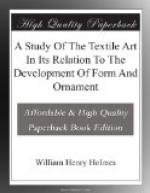Again, the ancient potter, who was in the habit of modeling his wares within baskets, seems to have conceived the idea of building his vessels by coiling just as he built his baskets. The surface exhibits coiled ridges like basketry, as shown in Fig. 353, and the textile character was further imposed upon the clay by marking these coils with the thumb and with implements to give the effect of the transverse series of filaments, and the geometric color patterns of the basketry were reproduced in incised lines. When these peoples came to paint their wares it was natural that the colored patterns native to the basketry should also be reproduced, and many more or less literal transfers by copying are to be found. A fine example of these painted textile designs is shown in Fig. 354. It is executed in a masterly style upon a handsome vase of the white ware of ancient Tusayan. Not only are the details reproduced with all their geometric exactness, but the arrangement of the designs upon the vessel is the same as in the textile original. Nine-tenths of the more archaic, Pueblo, ceramic, ornamental designs are traceable to the textile art, and all show the influence of textile convention.
[Illustration: FIG. 353. Earthen vase built by coiling, exhibiting decorative characters derived from basketry.]
[Illustration: FIG. 354. Ceramic ornament copied literally from a textile original.]
Another peculiar class of transfers of a somewhat more indirect nature may be noticed. All the more advanced American nations were very fond of modeling the human form in clay, a large percentage of vessels having some trace of the human form or physiognomy. Now, in many cases the costume of the personage represented in the clay is also imitated, and generally in color, the details of the fabrics receiving their full share of attention. Such an example, from a sepulcher at Ancon, is shown in Fig. 355. Here the poncho or mantle thrown across the shoulders falls down upon the body in front and behind and the stripes and conventional fishes are accurately reproduced. In this way both style and matter of the textile decoration are introduced into the ceramic art.
[Illustration: FIG. 355. Textile patterns transferred to pottery through the copying of costume. From The Necropolis of Ancon, by Reiss and Stuebel, Pl. 94.]
It will be seen by these illustrations that there are many natural methods, automatic or semiautomatic in character, by which the one art receives aid from the other; that in the beginning of the transfer of textile ornament to fictile forms the process is purely mechanical, and that it is continued automatically without any very decided exercise of judgment or taste. As a result, these borrowed decorations are generally quite as consistent and appropriate as if developed within the art itself. Later in the course of progress the potter escapes in a measure from this narrow groove and elaborates his designs with more freedom, being governed still to a certain extent by the laws of instinctive and automatic procedure. When, finally, intellect assumes to carry on the work independently of these laws, decoration tends to become debased.




